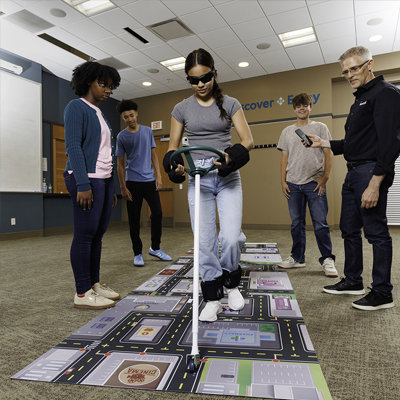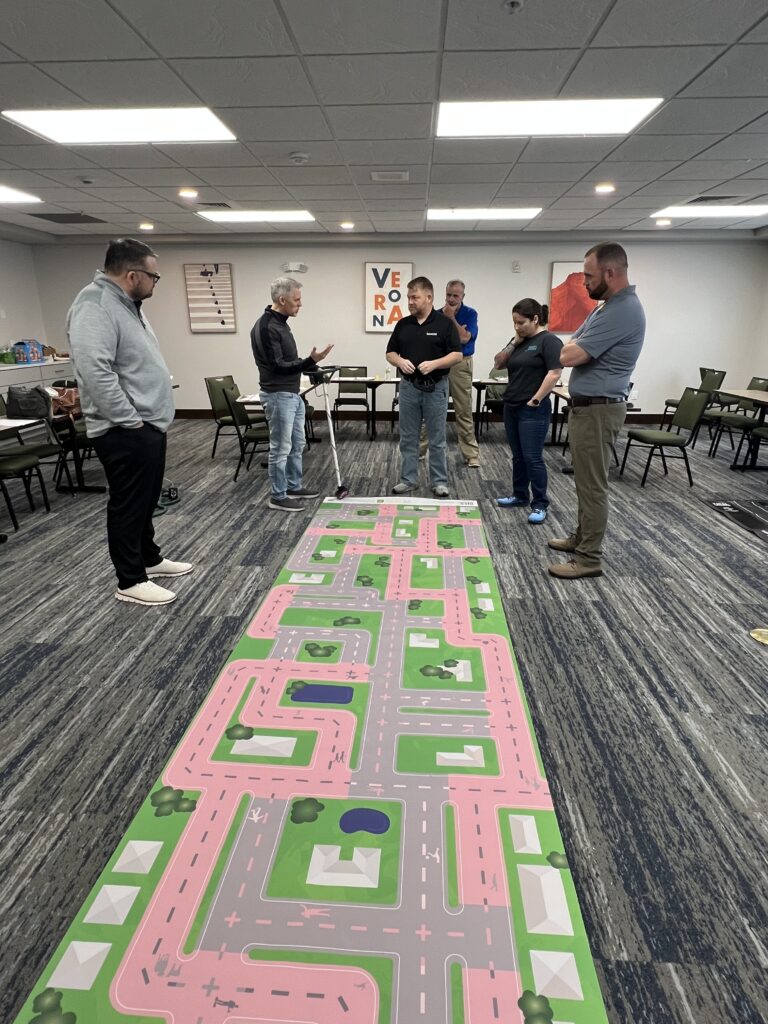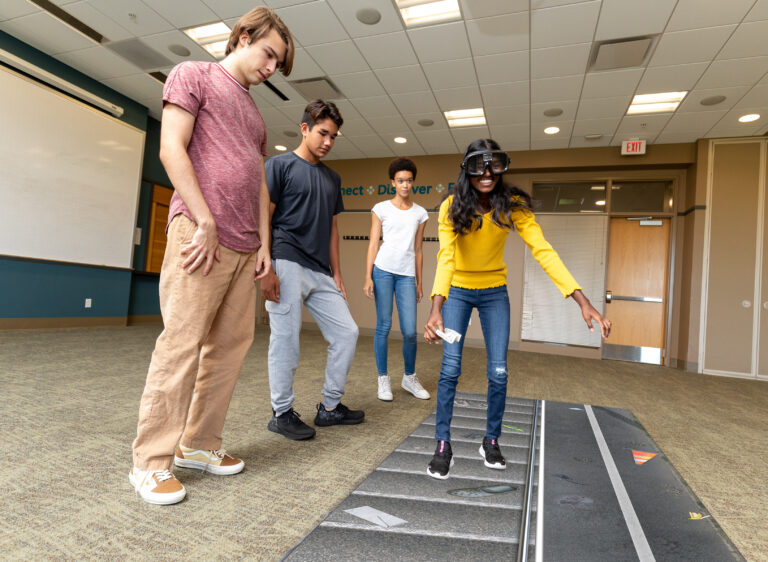
Opioid Education, Awareness, and Prevention
Keep students and young adults safe with awareness, education, and prevention learning opportunities. One of the key ways to help reduce opioid addiction among teens and young adults is awareness
Be First to Know About Fatal Speeding™ — Launching Early 2026! LEARN MORE

Incorporating engaging tools like Fatal Vision Impairment Simulation Goggles into educational settings can be a powerful experience. The goggles simulate impairment from alcohol or drugs and are often used to demonstrate the dangers of driving under the influence. But sometimes, presentations using these goggles elicit laughter from participants, which can initially be viewed as counterproductive.
However, if managed correctly, this reaction can become essential to an impactful learning experience. When interpreted as a signal of engagement, laughter can create the foundation for deeper understanding, leading to more meaningful outcomes. In this blog, we explore how to address laughter when using Fatal Vision Goggles and how to turn it into a valuable educational moment.
When participants first use the Fatal Vision goggles, there may be a moment of surprise when the participant realizes that their actions under the influence are impaired. Most participants react to this surprise or perceived embarrassment through laughter. For instance, when someone is doing a simple walk-the-line activity with the goggles and starts stumbling or stepping off the line, there may be a moment when their peers start laughing, leading to the participant laughing during their experience. When using the Fatal Vision THC Goggles and doing the Maze activity, the observers may start laughing the moment someone makes a mistake in solving the maze, but the participant may join in after they take off the goggles and realize their mistake.
When educators observe laughter during Fatal Vision Goggles demonstrations, they might wonder if their audience is truly grasping the serious message of impaired driving. Laughter can actually be an indicator of engagement. Laughter might not signify a lack of seriousness but rather signal that participants are paying attention.
Laughter can act as a social and cognitive tool. When participants laugh, they acknowledge the absurdity of performing simple tasks like walking or catching a ball while impaired. This moment of realization is often followed by reflection: if it’s this hard to do these tasks, how dangerous would it be to drive in a similar condition?
Engagement is the cornerstone of any educational experience. Without it, information is less likely to stick, and the ultimate goal of behavior change becomes harder to achieve.
The key to transforming laughter into a learning moment are the questions you ask. Instead of passively letting the laughter die down, educators can leverage it as an opening to introduce critical thinking. For example, after a humorous moment, you can ask participants to imagine driving a car under similar conditions. “What if you had a loved one in the passenger seat?” suddenly shifts the mood from humor to a more serious reflection.
It’s crucial to acknowledge the humor but immediately bridge it with real-world consequences. Laughter may be the first step, but engagement happens when participants start to ask deeper questions, allowing them to explore the implications of impaired driving more personally and seriously.
One of the most effective ways to encourage deeper understanding during a presentation is to move from a “lecture” style to an interactive discussion. Lectures and slideshows are common in many educational environments, but they can often fail to keep participants actively involved. With Fatal Vision Goggles, the hands-on experience is already more engaging than traditional methods, but how you ask questions during and after the demonstration can further enhance this engagement.
For instance, after participants try the goggles, instead of simply asking, “Was that fun?” educators can prompt participants to reflect critically on the experience. Ask them questions like:
These types of questions encourage participants to think beyond the immediate experience. It is important to create a story or narrative that is relatable to the participants as well as the impact of the impairment in that narrative. Real-life stories would also be readily received at this point because the participant realizes how susceptible they were in the experience. They’re no longer just performing tasks while wearing the goggles—they’re reflecting on how the experience translates to real-life situations that could affect them or their loved ones.
It is always important to have a trained instructor or facilitator for any Fatal Vision activity. Just like any tool in a toolbox, it is only constructive when it is in the hands of someone skilled enough to use it properly. The instructor must treat the goggles as an important tool to get students to realize the important message being presented. If there is no clear target, then the participants will be left to their imagination and will create their own message.
Creating a safe environment where participants can freely ask questions is crucial. When participants feel comfortable, they’re more likely to engage in meaningful discussions. The sense of safety allows participants to open up about their concerns and explore potential scenarios they might face in real life.
In this safe space, humor can break the ice. The laughter that arises from trying to perform tasks while wearing the goggles can be the tension relief needed to get participants talking. Once they’re comfortable, it’s easier to introduce difficult or serious topics, such as the real consequences of driving impaired. Let them understand that they may feel comfortable laughing at their reactions because this is a safe activity in a safe environment, but there are times when this type of impaired reaction would not be safe for themselves or others.
At the heart of any education program is the goal of empowering participants to make safer choices. Whether you’re presenting to high school students, college attendees, or the community, the ultimate goal is to reduce impaired driving and promote safer decision-making.
By using laughter as an entry point into deeper discussions, educators can help participants make connections between the goggles’ simulated experience and the real-world risks of impairment. The goal is to encourage them to ask questions, explore the potential dangers of impaired driving, and ultimately make more informed choices in the future.
Fatal Vision Goggles and driving simulators like the Roadster Pedal Karts or SIDNE Vehicles are incredible tools for teaching about the dangers of impaired driving. While laughter might initially seem like a distraction, it can be a vital tool in promoting engagement and reflection. The key is knowing how to guide participants from humor to critical thinking. By asking thoughtful, reflective questions, educators can create moments where participants connect the fun experience with real-world consequences.
At the end of the day, it’s about creating an environment where learning can happen through engagement, conversation, and reflection. Next time you see laughter during a Fatal Vision Goggles demonstration, embrace it—it might just be the key to making your message stick. Fatal Vision Product Training is a great way to maximize your education program and learn more about educating with Fatal Vision Goggles.
Innocorp is the pioneering developer of Fatal Vision® Goggles and other experiential learning tools designed to educate on the dangers of impairment and promote risk prevention. Innocorp provides impactful, hands-on resources used globally by law enforcement, educators, and safety professionals to demonstrate the consequences of substance use, risky driving, and other dangerous behaviors.
We’d love to online chat! We are available Monday-Friday from 8am-5pm (CST):
Or schedule a time for a consultation:

Keep students and young adults safe with awareness, education, and prevention learning opportunities. One of the key ways to help reduce opioid addiction among teens and young adults is awareness

Here’s an overview of what to expect and some benefits of investing in on-site Innocorp product training. Educators deserve great training to facilitate participant learning and instruction in their

Empathy and Awareness Before Behavior Change: A Balanced Review of Impairment Simulation Tools Executive Summary Simulation tools such as Fatal Vision® goggles give participants a vivid, first-person sense of